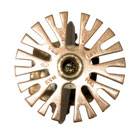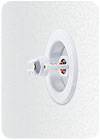
Editor’s Note: “Back to Basics” is a column that will run periodically inPM Engineerreviewing the basic principles of plumbing engineering.
Two or three times a month, while I’m conducting training seminars for specifying engineers and contractors, I’ll ask the following question: “How many different types of automatic sprinklers do you think are available to you, the specifying engineer, in the market today?” Usually, a quick look of panic comes over many of the faces of the attendees as they quickly attempt to calculate the number of different automatic sprinklers their company uses.
So, I follow up with a second question: “Approximately how many ‘SIN’ or sprinkler identification numbers are typically offered by any one of the major sprinkler manufacturers?” For some, the term “SIN” adds a degree of doubt into their response because many people involved in the fire protection industry are still not familiar with the term.
So, at this point, I end the exercise and provide the answer. Today, the major manufacturers of automatic sprinklers each offer between 300 to 400 sprinklers identified by a unique “SIN” sprinkler identification number. The term “sprinkler identification number” was introduced to the industry in 2001 and first incorporated into National Fire Protection Association (NFPA) 13 in the 2002 edition within section 6.2.2.1, which requires sprinklers to be permanently marked with a one- or two-character manufacturer symbol, followed by three or four numbers, to uniquely identify the sprinkler.
My point has been made to the seminar attendees: The days of the sprinkler industry-where there was the sprinkler that went up, the sprinkler that went down, and the sprinkler that came out of the wall-are long gone and have been for some time. The challenge for the engineer now becomes how to decipher the mountains of marketing and technical data and specify the proper sprinkler.
In today’s sprinkler market, it is no longer possible for anyone to have the encyclopedic knowledge of the available sprinkler options some had in the past. Market demands have driven the sprinkler innovations to become specialized, and in some cases, unique to one application. I must admit that working for a major manufacturer gives me an advantage, but I still find it challenging given the current new product release rate of one to two new sprinklers a month.
So the two main questions I receive in return from those seminar attendees are these:
1. How do I, the specifying engineer, ensure the correct sprinkler is specified for my project?
2. How do I keep up to date on all of these new sprinkler innovations?
Both are excellent questions, given the amount of sprinklers available and the lack of extra time in the workday to keep on top of all these new products.

Close-up
overhead view of a standard sprinkler. Photo courtesy of The Viking Corp.
Use "SIN"
Sprinkler technology has progressed tremendously over the last 10 to 15 years. It is certainly common practice by many engineering firms today to place a generic performance specification out for bid on many projects and let the contractor who is awarded the project select the appropriate sprinkler. This practice works great in some cases, and the professional fire protection contractors within the industry do a wonderful job of providing quality sprinkler installations. However, some engineering firms prefer to be more involved in the system design. It is in these situations that a more precise description of the sprinkler is required in the specification.Sprinkler identification numbers are the key to specifying exactly what sprinkler you require for a specific project. These numbers change for every change in orifice size or shape, deflector characteristics, pressure rating and thermal sensitivity. Today, it is not practical to just call out a manufacturer’s model name. Model names are typically “brand” information and do not really identify what is being called for.
Given what I have previously said about the large amount of sprinklers available on the market, some who are reading this are more than likely saying: “‘SIN’ numbers are just fine, but who has the time to keep up with all of this information?” The answer is more than likely just about nobody. In order to keep up to date on sprinkler information today, specifying engineers should take advantage of the technical services offered by some manufacturers, including their internet Web sites, technical service departments, product seminars and “lunch and learn” seminars. Recognizing the need to make the steady stream of technical information available to engineering firms and contractors, some manufacturers have made these services readily available.

Figure
1. Application Groups of Sprinklers
We All Play by the Same Rules
At times, there can be a lot of misinformation circulating throughout the fire protection industry. The first step in ensuring a quality specification is to understand that, as manufacturers, we all play by the same rules. Understanding what the rules are and how to incorporate them into your specifications is an essential part of the process.The consulting engineer must be able to identify the difference between marketing materials and technical documents. Marketing is a wonderful thing. We all want the companies we work for to be as successful as possible. Marketing products correctly is an essential process within the industry and is needed in order to get information out to the engineering community. However, marketing documents and information contained in them should not be confused with technical documents. Marketing information should be used as a reference only.In order to gain the ability to quickly identify marketing or technical information, there is no substitute for foundation knowledge of the relevant industry standards. If you are involved in the selection and specification of automatic sprinklers, you must familiarize yourself with the requirements of the Underwriters Laboratories Inc. (UL) manufacturing standards such as UL 199, the FM Global (FM) loss-prevention guidelines and NFPA 13 Installation of Sprinkler System Standard as a minimum.
How many specifications are released that require UL-listed and FM-approved products to be installed in accordance with NFPA 13? I will put myself out on a limb and say just about all of them. However, a surprising amount of people within the industry are familiar with the names, but have no knowledge of the individual organizations, standards or the information contained within.
My point is that a UL listing and an FM approval are not the same thing. In some cases, it is not possible to have a product that is UL-listed and FM-approved. Let me provide three quick examples. First, concealed sprinklers. Many specifications ask for UL-listed and FM-approved quick response concealed sprinklers. This is not possible because FM does not approve quick response concealed sprinklers. FM-approved concealed sprinklers will all be standard response.
Second, many specifications will require UL-listed and FM-approved corrosion-resistant sprinklers. There are big differences between what FM approves as corrosion resistant and what UL lists as corrosion resistant. They are not the same.
Finally, the listings and approvals for early suppression fast response (ESFR) sprinklers and the UL and FM required starting pressures can be dramatically different for many of the same applications.
I’m providing these three examples, and there are many more that I can point to, in order to illustrate the point that when the specifying engineer requires these listings and approvals, you should never make the assumption that they mean the same thing. The UL listing guide, FM approval guides and FM loss-prevention data sheets can be purchased from these organizations for your review.
Understand the Basic Groups and Application of Sprinklers
The easiest way to start to distinguish how various sprinklers are applied is to separate them into the three main application groups: control mode sprinklers, suppression mode sprinklers and residential sprinklers. Separating the sprinklers into these three groups helps to understand quickly which section of NFPA 13 becomes relevant and then what installation rules will apply to the specified sprinkler.
This allows the specifying engineer to quickly identify the types of sprinkler required and removes irrelevant information from the selection process.Figure 1provides a quick illustration.

The
VK630 is a thermosensitive spray sprinkler featuring a small glass bulb
operating element and special deflector. Courtesy of The Viking Corp.
Online Technical Data Sheets
Many within the industry do not realize that technical data sheets are part of the listing and approval process. The technical data sheet is the official document on any UL-listed or FM-approved product. Information for specifications should be taken from these documents only.In today’s information-driven society, the Internet has become the primary method of releasing technical information to the field. Many of us have resisted the conversion from our faithful paper databooks with years of notes and sketches to getting information from Web sites and CDs. Unfortunately, the days of the paper databook seem to be gone.
In many cases, manufacturers no longer offer paper technical databooks, and more than likely they would be of little value if they did. The reason for this is simply because they will be out of date almost immediately after being published in many cases. The volume of sprinklers being introduced by all of the manufacturers makes it close to impossible to keep these books up to date.
For the most accurate and up-to-date information to include in specifications, the Web sites are the place to visit. Web sites also allow the manufacturers to make available CAD drawings, listing and approval documents and other technical resources that were never easily retrievable in the past. The Web site also breaks the sprinklers down into the categories I mentioned earlier, so information is generally easy to find.
Conclusion
The specification of automatic sprinklers has become much more difficult than it was in the past. By using simple techniques, such as incorporating sprinkler identification numbers into specifications, the consulting engineer can ensure that the exact sprinkler required for the project is submitted and installed. Taking advantage of the numerous technical services offered by manufacturers to keep the firm up to date on technical information is no longer optional in many cases. Such services can provide an easy, no-cost avenue to current sprinkler educational information.
The most important step in the process, however, lies with the engineers themselves. Keeping up to date on the installation standards, participating in the NFPA technical committees and becoming familiar with the foundation documents used in the industry go a long way to ensure the correct product is specified for the application.